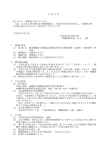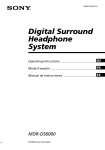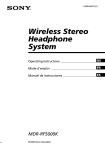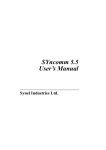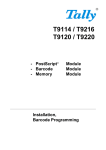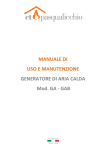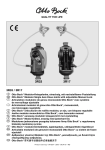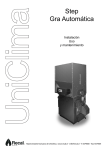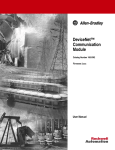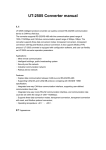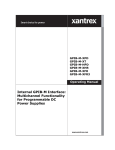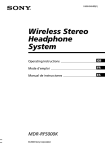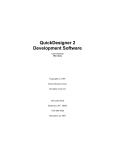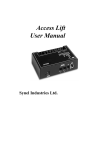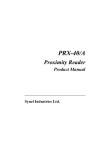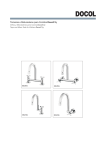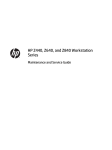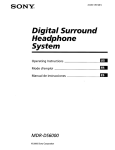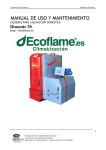Download The Synel Communication Protocol User`s Manual - Synel-USA
Transcript
The Synel Communication Protocol User’s Manual Synel Industries Ltd. This manual was issued on 4/28/08. Catalog no. 660004 Document no. SYPROT-222-03 This document has been prepared for SY7XX firmware version 6.209. Copyright © 1993-2007 Synel Industries Ltd. All rights reserved. Reproduction or use, without express permission of editorial or pictorial content, in any manner is prohibited. No patent liability is assumed with respect to the use of the information contained herein. While every precaution has been taken in the preparation of this manual, Synel Industries Ltd. assumes no responsibility for errors or omissions. Neither is any liability assumed for damages resulting from the use of the information contained herein. SY is a trademark of Synel Industries Ltd. All trade names referenced herein are either trademarks or registered trademarks of their respective companies. Synel Industries Ltd. Table of Contents 1.Overview ..................................................................................... 7 1.1Convention ............................................................................ 7 1.2Commands sequence ............................................................. 7 1.3Format of commands and replies .......................................... 7 1.3.1Command....................................................................... 8 1.3.2Reply.............................................................................. 8 1.3.3Standard reply ................................................................ 8 1.3.4Multidrop ID.................................................................. 8 1.3.5Cyclic Redundancy Check (CRC) ................................. 8 1.3.6EOT.............................................................................. 10 2.Commands list .......................................................................... 10 2.1Host commands sent to the terminal(s) ............................... 10 2.2Terminal commands to the host........................................... 12 2.2.1Primary commands ...................................................... 12 2.2.2Secondary commands .................................................. 12 3. Host - Terminal Command sequences................................... 13 3.1Terminal status sequences.................................................... 13 3.1.1Send Status................................................................... 14 3.1.2Set status ...................................................................... 16 3.1.3Set Technician Parameters ........................................... 17 3.1.4Get Current Parameters................................................ 18 3.1.5Get Hardware Configuration Parameters from Terminal ............................................................................... 19 3.1.6Get Network Configuration Parameters from Terminal ............................................................................... 22 3.2Online communication and data collection ......................... 23 3.2.1Send data...................................................................... 23 3.2.2Send all (data) .............................................................. 25 3.2.3Acknowledge last record ............................................. 27 3.2.4Clear buffer .................................................................. 27 3 3.2.5Clear by date ................................................................ 3.2.6Reset buffer.................................................................. 3.2.7Reset line ..................................................................... 3.3Programming ....................................................................... 3.3.1Halt .............................................................................. 3.3.2Table(s) Loading .......................................................... 3.3.3Table(s) Deleting ......................................................... 3.3.4Table(s) Replacing ....................................................... 3.3.5Run............................................................................... 3.3.6Command verification ................................................. 3.4Special host display ............................................................. 3.5System Commands .............................................................. 3.5.1Special System Command ........................................... 3.5.2Save Parameters into Flash.......................................... 3.5.3Restore parameters from Flash .................................... 4.Fingerprint unit commands .................................................... 4.1Conversion process.............................................................. 4.1.1Enrolment conversion procedure................................. 4.1.2Verification conversion procedure............................... 4.1.3Conversion algorithm .................................................. 4.2General characteristics ........................................................ 4.3Commands........................................................................... 4.3.1The Request template................................................... 4.3.2Get template................................................................. 4.3.3New Template .............................................................. 4.3.4Status Type................................................................... 4.3.5Set FPU Parameters/ Enrol Mode................................ 4.3.6BlockTemplateList....................................................... 4.3.7Acknowledge ............................................................... 4.3.8Not available................................................................ 4.3.9Delete template ............................................................ 4.4Set FPU Parameters............................................................. 4.4.1SynGetFPUStatus ........................................................ 28 28 29 29 29 31 33 34 36 37 38 39 39 39 40 41 41 42 42 42 45 45 46 47 50 51 53 56 58 58 59 60 60 4 4.4.2Check Template ........................................................... 61 4.4.3Fingerprint Parameters................................................. 62 4.4.4Error Code List (NNN)................................................ 64 5.Firmware upgrade commands ................................................ 68 5.1Commands........................................................................... 68 5.1.1SwitchToFirmwareUpdateMode.................................. 68 5.1.2SendFirmwareBlock .................................................... 70 5.1.3GetFirmwareBlock ...................................................... 72 5.1.4SwitchToWorkingMode............................................... 74 5.1.5ClearMainFlash............................................................ 75 6.Glossary..................................................................................... 77 6.1Data Records Status:............................................................ 78 A.1General ............................................................................... 79 A.2Header structure.................................................................. 79 A.2.1Table A – Header structure.......................................... 80 A.3System tables ...................................................................... 81 A.3.1Table B- Header of system tables................................ 82 A.3.2System parameters table record format ...................... 85 A.3.3Day Light Saving Time parameter structure............... 87 A.3.4TRP record structure................................................... 89 A.4Record structure of MPL .................................................... 92 A.4.1Display @-Sequences formats.................................... 92 A.5Printer @-Sequences formats ............................................. 94 A.6Algorithm for Synel’s numeric fields ................................. 95 A.6.1Multi-drop ID algorithm ............................................. 95 A.6.2HighByte + LowByte algorithm ................................. 95 A.6.3HighByte + MiddleByte + LowByte algorithm*........ 95 B.1Fingerprint templates .......................................................... 99 C.1Template Header Structure (SYNEL) ............................... 102 C.2Change security threshold for a single template:.............. 102 C.3Replacing a template ID (card number): .......................... 103 5 1. Overview The protocol is the commands used by Synel’s data collection terminals. All communication sequences are initiated by the host. The host computer polls the terminals, it queries each terminal for data records or fingerprint templates. If the terminal replies Yes then data transmission is permitted. A No reply means that the host moves on and polls the next terminal. This process is repeated continuously. Host commands transmission can be performed comprehensively to all terminals or to a specific terminal. If the command is directed to a specific terminal (except the RESET LINE command), the terminal is obliged to produce a reply. The terminals are programmed by the host, therefore the host instructs the terminals to enter into programming mode before transmitting programming commands. Commands transmitted by the host have a different structure than the commands received from the terminal, thus each command group is described separately. 1.1 Convention Bit Type = [O..1); One bit Nibble Type = [0..15); four bits Byte Type = [0..255); eight bits Word Type = Two Bytes; 16 bits 1.2 Commands sequence The command sequence starts with a host command followed by a reply from the terminal. Both the command and the reply sequence includes the operation code followed by the terminal’s multidrop ID. This is followed by applicable data, the sequence ends with a 4-byte Cyclic Redundancy Check (CRC) and a 4-byte - End of Transmission (EOT) character both in hexadecimal. Other characters are written in printable ASCII. 1.3 Format of commands and replies Each command or reply is organized in the format shown below: Command or reply 1 byte Multidrop ID of a specific terminal or @ for all terminals 1 byte 7 Data field Communication CRC End of command or reply (EOT) 1.3.1 up to 128 bytes 4 bytes 1 byte Command A command is sent from the host computer to a specific or to all terminals. 1.3.2 Reply A reply is the terminal’s response to a command. It is sent in the same format as the command. 1.3.3 Standard reply The terminal replays ACK (06h) unless a specific reply is requested, that is if the host command was received correctly. The host anticipates a reply within 50 milliseconds of the programmed time-out. If replay was not received within scheduled time, the host assumes that the terminal did not received the command and it will be resent. 1.3.4 Multidrop ID The ID represents the terminal position on a multidrop line, definition range between 0 and F hexadecimal format. Up to 32 terminals may be connected to a single multidrop line, via a single computer port. Synel’s software identifies the communication port as well as the terminal’s multidrop line position. Multidrop ID includes only terminal position, since the protocol is sent along one specific multidrop line. The multidrop ID is exchanged with the @ character, this when command is transmitted to all terminals connected to the multidrop line and not designated to a specific terminal. Not in use with the commands: E, G, I, K and L. 1.3.5 Cyclic Redundancy Check (CRC) The protocol’s error-detecting capabilities, a number of 4 bytes generated and appended to the end of a block of data to provide error detection. The CRC performs 16 bit operations on each byte: Definitions 1. RA, RB, RC, RD 16 bit registers. 8 2. 3. Rn register Rn(H)- Least Significant Bit (LSB) 8 bit register. Rn(L)- Most Significant Bit (MSB) 8 bit register. Rn(SR)*i - Shift Right of i bits with leading zeros. Rn(SL)*i - Shift Left of i bits with trailing zeros. XOR - OR operation: A 0 0 1 1 B 0 1 0 1 A^B 0 1 1 0 CRC start registers: RC register will contain the last computed CRC bytes (zero at initialization). RA(L) register contains the next character (8 bits). CRC end registers: RC register will contain the new CRC bytes. CRC Algorithm RD<-----RC RA(H)<--0 SR(RC)*8 RC<-----RC XOR RA RB<-----RC SR(RC)*4 RC<-----RC XOR RB RB<-----RC SL(RC)*5 RC<-----RC XOR RB SL(RD)*8 RC<-----RC XOR RD RB<-----RC SL(RC)*12 RC<-----RC XOR RB Transformation of the computed CRC into ASCII characters The computed CRC can be represented by a sequence of four hexadecimal characters, each of which will be translated into an ASCII character by adding the nibble 3 hex to its left. For example: The addition of the 3 hex nibble to the left of A hex results 3A hex. 9 Example 1 Computed CRC ASCII representation 1234 hex"1234" 9AF0 hex"9:?0" Example 2 Two characters computed CRC ASCII representation "A4" "482:" "B4" "1=79" "C4" "2>48" "D4" ";7=?" 1.3.6 EOT The End Of Transmission (EOT) is 04 hex. 2. Commands list The commands tables contains a description of commands transmitted from the host to the terminal and the commands received from the terminal: • Commands format is case sensitive. • Lowercase letters cannot be replaced with uppercase letters and vice versa. 2.1 Host commands sent to the terminal(s) Definition A SEND DATA B SEND ALL C CLEAR BUFFER Description Initiates a sequence for terminal transmission of a full data block of up to 128 bytes. Initiates sequence for a terminal transmission of a partly-full data block. Directs terminal to clear all transmitted and acknowledged records stored at the memory buffer. 10 c CLEAR BY DATE D E F G I K L O Q R S V Directs terminal to clear all transmitted and acknowledged records stored at the memory buffer according to the specified date. GET STATUS Initiates a sequence receiving data on the terminal's status. SET STATUS Initiates a sequence that sets the terminal's internal clock. ACKNOWLED The host has received the terminal’s last data record GE LAST trasmission and it forwards a notification. RECORD RESET Directs the terminal to reset all transmitted and BUFFER acknowledged records and mark them as unsent stored records. TABLE Initiates a sequence for table operation excution as; OPERATION load, delete, replace. HALT Commands the terminal to terminate normal operation mode and proceed to programming mode. RUN Commands the terminal to terminate programming mode and proceed to normal operation mode. SEND ONLY Sends an existing query, not sent if data was not found. QUERY An N is sent if QUERY does not exist. QUERY The terminal produces the query response. There are REPLAY three responses T=Timeout, O=Offline, B= Buzy for host, L=Long query RESET LINE Directs the terminal to terminate transmission, reestablish communication and waits for the next SEND DATA for SEND ALL command. SYSTEM Memory commands form the terminal to the host COMMANDS Fingerprint For SY780 terminals V-HOST, Version 5.0.3 v-TERMINAL 11 2.2 Terminal commands to the host 2.2.1 Primary commands These commands always appear in lowercase letters and may accompanied by secondary commands, See page -12. Command Definition b BUSY d n q s t v ACK (06hex) NACK (15hex) 2.2.2 Description The terminal is currently busy and temporary unable to respond the host command. DATA RECORD The command is accompanied by a data record. NO DATA Data stored on the terminal that meets the host request parameters is not found. QUERY FOR There is a terminal query directed to the HOST host. TERMINAL The command is accompanied by a data STATUS that represents the terminal current status. BLOCK The terminal ackwnoladges receiving the RECEIVED transmitted host block. LAST The command is accompanied by a data COMMAND that represents the last received command from the host and whether it is comprehensible to terminal. ACKNOWLEDG Terminal acknowledgs that the host E command was received clearly. NOT Terminal notifices that the host command ACKNOWLEDG was not received clearly. E Secondary commands The secondary commands are transmitted when the terminal denies accepting the tables programming at the current time. These commands describes the cause for not accepting the programming tables, they are always appear in 12 uppercase letters. Command Definition C IN PROGRAMMING MODE E TABLE ALREADY EXISTS F MEMORY FULL G BLOCK REC. AND BEING STORED L PERFORMING LAST COMMAND R TRANSACTION IN PROGRESS W BLOCK RECEIVED AND STORED 3. Description The terminal is currently ready to receive programming tables and denies accepting transaction input. A table with the same ID already exists in the terminal's memory. The terminal's memory is full. A data block was received and processed to be stored at the terminal's memory. The command execution is in process by the terminal. A transaction input is currently in progress at the terminal. A data block was received and already stored at the terminal's memory. Host - Terminal Command sequences The communication protocol between the host computer and the terminals is organized into five different groups: • Terminal status • Online communication and data collection • Programming • Command verification • Special host displays 3.1 Terminal status sequences There are two protocol sequences which work affect the terminal’s status: • Send status • Set status 13 3.1.1 Send Status This sequence logs terminal status . Terminal reply Host command Command D (44h) Data Bytes Command s (73h) multidrop ID 1 or @ CRC 4 EOT 1 P Data Bytes multidrop ID or @ 1 model no. (0-9) version no. (0-9) terminal ID terminal status (year) terminal status (month) terminal status (day) terminal status (hour) terminal status (minute) Active function P: Z = Crash status i = Init mode T = Technician mode P = No program mode b = Blocked A....0 - Active functions A,B, Number of full buffers Number of faulty buffers Number of full buffers transmitted and not cleared Number of empty buffers Memory used for tables 1 1 5 2 2 2 2 2 1 3 3 3 3 5 14 Station type: A - SY-110 B - DCM-100 C - SY-101x D - SY-70x E - SY-71x, SY-75x, SY77x M- SY400 m - SY400 on SY78x hardware V - SY78x v - SY760 ? - Unknown type 0 - DCT 2 - SY-125 3 - SY-120h 4 - SY-130 6 - SY-180 8 - SY-101e 9 - SY-101h 1 Power status: 0 = Power off 1 = Power on UserDefinedField NetworkProtocol: ‘-’ Network not supported N - Network card not present T - TCP/IP U - UDP Network Polling Interval: -- Network not supported 1 4 1 2 15 Fingerprint mode: 1 M - Terminal Master mode S - Terminal Slave mode - FPU not supported Reserved 12 CRC 4 EOT 1 3.1.2 Set status This sequence sets the terminal’s time and active function. Command E (45h) Host command Data Terminal reply bytes Command Data ACK (06h) multidrop ID or @ 1 Year Month Day Hour Minute Active function Seconds (optional) CRC EOT 2 2 2 2 2 1 2 4 1 bytes M.ID (according 1 to the ASCII table @=all CRC 4 EOT 1 16 3.1.3 Set Technician Parameters Sets new values for technician menu communication parameters. Location 1 2 Length 1 1 Name Op-code ID Name S 0-31 3 3 Sub-code HPS 6 8 9 2 1 1 New ID Serial Port #0 Serial Port #1 00-31, -0 1 or 3 10 1 Serial Port #2 2 or 3 11 1 12 13 1 1 14 1 Baud rate for -,0-7 host Baud rate for FP-,0-7 Baud rate for -,0-7 PRINTER Number of N,-,0-9 modem ring 15 1 Net card type 16 20 4 1 CRC EOT A-F Set hardware M.ID (according to the ASCII table @=all Hardware Parameter Set New M_id value Used only for Host FPU or Serieal smartcard reader. Printer or Serieal smartcard reader. See “Baud Rate Table” See “Baud Rate Table” See “Baud Rate Table” If modem does not exist put N Otherwise the number of rings to answer the call. A- Ethernet 10 Mbps B – Ethernet 10/100 Mbps C- N. Used D- Bluetooth E- Wi-Fi F – Ethernet 100 Mbps The reply to this command is ACK or NACK with old setting, the setting is only changed after acknowledging. 17 Baud Rate Table The following table displays the value to use and the baud rate it represents. 0 1 2 3 4 5 6 7 3.1.4 Baud rate 1200 2400 4800 9600 19200 38400 57600 115200 Get Current Parameters Returns the current values for technician menu communication parameters. Location Length 1 1 2 1 Value S 3 6 10 HPG 3 4 1 04Hex Desc. Opcode M.ID (according to the ASCII table @=all Sub code CRC EOT Reply from terminal: Location Length Name 1 1 Op-code 2 1 ID Value S 0-31 3 6 8 9 HPG 00-31, -0 1 or 3 3 2 1 1 Sub-code New ID Serial Port #0 Serial Port #1 Desc Set hardware M.ID (according to the ASCII table @=all Hardware Parameter Set New M.Id value Used only for Host FPU or Mifare R/W 18 10 11 12 13 1 1 1 1 14 1 15 1 Net card type 16 20 4 1 CRC EOT 3.1.5 Serial Port #2 2 or 3 Baud rate for host -,0-7 Baud rate for FP -,0-7 Baud rate for -,0-7 PRINTER Number of N,-,0-9 modem ring A-F Printer or Mifare R/W See “Baud Rate Table” See “Baud Rate Table” See “Baud Rate Table” If modem does not exist put N Otherwise the number of rings to answer the call. A- Ethernet 10 Mbps B – Ethernet 10/100 Mbps C- N. Used D- Bluetooth E- Wi-Fi F – Ethernet 100 Mbps Get Hardware Configuration Parameters from Terminal Returns the current values for technician menu communication parameters. Location 1 2 3 Length 1 1 1 Value S 1 H 4 5 8 1 3 1 G 04Hex Desc. System command Multidrop ID Hardware configuration SRC EOT 19 Reply from terminal: Location Length Name 1 1 System command 2 1 Multidrop ID 3 1 Hardware configurat ion 4 1 General 5 2 Terminal model 7 2 9 1 10 12 22 1 Value S Desc System command 1 Multidrop ID H Hardware configuration G 08/04 08 - SY-780/ SY-760/ SY-400 04 - SY-75x/ SY-777/ Firmware 00/02 00 - Firmware version 02 - Firmware subversion Firmware 0-2 0- SY-760 (1 COM port) subversion 1- SY-780 (3 COM ports) and FPU type 1 or 2 2- SY-780 (3 COM ports) and FPU type 3 Date @dd.mm. Date proceeded by a @ symbol yyyy in dd.mm.yyyy format Terminal M/V/v/E M - SY-400 - Metal box type V - SY-78x v - SY-760 E - TimeLOG 20 23 1 Keyboard F/D/B/b type 24 1 Display type 25 26 27 28 29 1 1 1 1 1 30 31 1 1 32 4 Seriel ? parameter ? s ? ? Terminal 0-9 or A-P ID FPU type 1-3 FPU M/S/N Terminal mode CRC O/T/R/G F - Function only keyboard (6 keys + BAT) SY-71x/75x D - Dual keyboard function and numberic keys (12 keys + BAT) SY-71x/75x B - Big keyboard function, numberic and service keys (24 keys + BAT) SY-780/777 b - Big keyboard function, numberic and service keys (22 keys + BAT) SY-760 O - Single line display 1x16 T - Double line display 2x16 R - Double line display 2x16 with Russian charecters G - Graphic display (future use) Bits Parity Stop bits Baud rate index ? M - master S - slave N - FPU not present 21 21 1 EOT For example:[email protected]. 3.1.6 Get Network Configuration Parameters from Terminal Returns the current values for technician menu communication parameters. Location 1 2 3 4 5 8 Length 1 1 1 1 3 1 Value S 1-9 H N 04Hex Desc. System command Multidrop ID Hardware configuration Network CRC EOT Reply from terminal: Location 1 2 4 Length 1 2 1 5 6 7 1 1 1 8 10 2 1 Name System command Multidrop ID Hardware configuration Network Network card Polling mode and MAC sending mode Value S 1-9 H Polling interval Network Protocol n 0/1 N A/B/D/E 0-3 Desc 0 - No 1 - Network polling 2 - Network MAC send 3 - Polling mode and Network MAC send in seconds 0 - TCP/IP 1 - UDP 22 11 12 MAC address 23 8 IP address 31 8 Gateway in Hex format xx.xx.xx.xx .xx.xx xx.xx.xx.x x xx.xx.xx.x x 39 8 IP remote address xx.xx.xx.x x 47 8 Subnet mask xx.xx.xx.x x port number port number 55 5 Terminal port 60 5 Remote port 65 70 5 1 Diconnect time DHCP 71 2 Network card Firmware version 73 76 3 3.2 Online communication and data collection 0/1 04Hex in seconds 0 - Off 1 - On CRC EOT The data collection process uses the following sequences. 3.2.1 Send data The following sequence designated for a full-data block transmission. A complete sequence results with a sent and acknowledged representation for 23 all records transmitted to the host. Terminal reply (if there is data) Host command Command A (41h) Data Bytes Command d (64h) Data Multidrop ID CRC 1 Multidrop ID 4 data EOT 1 Bytes 1 up to 128 CRC 4 EOT 1 Go to the F or C command on page page -12 . Terminal reply (if there is no data) n (6Eh) multidrop ID CRC EOT 1 4 1 Terminal reply (if online) q (71h) multidrop ID terminal ID last transaction (16-N) CRC EOT 1 5 4 1 Terminal online connection promotes the following sequence interchange between host and terminal: Command Q (51h) Host response Data multidrop ID Terminal acknowledgment Bytes Command Data Bytes ACK (06h) 1 multidrop ID 1 24 allowed/not allowed (Y/N) or Long (L) - (Y/N) and length of date in 2 bytes message to be displayed (1) no. of seconds to be displayed 1-9,# (2) reserved for future use CRC EOT 1 CRC 4 16 EOT 1 7 4 1 Note: 1. 2. 3.2.2 If # is entered 16 times, the programming tables text definitions will be in use. If # is entered, the programming tables seconds number definitions will be in use. Send all (data) The following sequence designated for a partly-full data block transmission. A complete sequence results with a sent and acknowledged representation for 25 all records transmitted to the host. Host command Terminal reply (if there is data) Command B (42h) Data multidrop ID CRC EOT Bytes Command d (64h) 1 Data multidrop ID Bytes 1 data up to 128 CRC 4 EOT 1 Go to the F or C command on page page -12. Terminal reply (if there is no data) n (6Eh) multidrop ID 1 CRC 4 If the terminal is connected online, the host will respond to the terminal’s reply as either by short or long message. Short message: Command Q (51h) 4 1 Host response Data Bytes multidrop ID or @ 1 allowed/not allowed (Y/N) message to be displayed no. of seconds to be displayed (1-9,#) reserved for future use CRC EOT Terminal acknowledgment Command Data Bytes ACK (06h) 1 1 multidrop ID CRC 16 EOT 1 4 1 7 4 1 26 Long message: Host response Terminal acknowledgment Command Q (51h) Data Bytes 1 multidrop ID or @ 1 L (4Ch) Long message identification Allowed/not allowed (Y/N) Data string: 99 max. Data as per length 1 CRC EOT 3.2.3 Command ACK (06h) Data Bytes multidrop ID 1 1 CRC 4 2 up to 99 4 1 EOT 1 Acknowledge last record The host employs the following sequence to acknowledge receiving the last record from the terminal. A complete sequence results with a sent and acknowledged representation for all records transmitted to the host. The terminal will not clear the acknowledged data from its memory buffer until commanded to do so by the host. Host response Command F (46h) Terminal acknowledgment Data multidrop ID CRC EOT 3.2.4 Bytes 1 4 1 Command ACK (06h) Data multidrop ID CRC EOT Bytes 1 4 1 Clear buffer This sequence commands the terminal to clear all data records marked as sent and acknowledged from its memory buffer, including the last data record transmitted but was not acknowledged. A complete sequence results with a 27 cleared memory buffer (page below). Command C (43h) Host command Data multidrop ID CRC EOT 3.2.5 Bytes Command ACK (06h) 1 Terminal reply Data multidrop ID CRC EOT 4 1 Bytes 1 4 1 Clear by date This sequence commands the terminal to clear data records marked as sent and acknowledged from its memory buffer, according to specified date. Host command Terminal reply Command c (63h) 3.2.6 Data Bytes Command ACK (06h) multidrop ID 1 Date as DDMMYY format CRC EOT 6 4 1 Data Bytes multidrop ID 1 CRC EOT 4 1 Reset buffer The sequence commands the terminal to reset all data records marked as sent and acknowledged to unsent records. Host command Command G (47h) Data multidrop ID CRC Terminal reply Bytes 1 Command ACK (06h) Data multidrop ID Bytes 1 4 28 EOT 3.2.7 1 CRC 4 Reset line The sequence commands the terminal to terminate all transmission to the host, initializing the communication settings, and wait for the host to send a SEND DATA or SEND ALL command before resuming transmission. The resumed transmission starts at the terminal with the first data record that has not be acknowledged by the host. Host command Command Data R (52h) Bytes Multidrop ID CRC EOT 3.3 Terminal does not reply or acknowledge None 1 4 1 Programming The following sequences are used to program Synel’s terminals. 3.3.1 Halt This sequence is of terminating normal operation mode and proceeding to programming mode commands. Programming is displayed, accepting the terminal inputs are denied. It is essential to invoke terminal’s programming mode in order to perform programming procedures. Host command Terminal reply Command Data Bytes Command Data Bytes If in programming mode ACK (06h) K (4Bh) multidrop ID or 1 @ CRC 4 EOT 1 multidrop ID 1 CRC EOT 4 1 29 When a data input is received (busy) b (62h) multidrop ID 1 CRC EOT 4 1 R (72h) The HALT command may be resent Reply if the terminal is being programmed b (62h) multidrop ID 1 programming operation type (S, D or R) type of table table ID CRC EOT 1 C (63h) 1 3 4 1 Reply if the terminal is processing the last command b (62h) multidrop ID 1 Go to the L command page -12 . CRC 4 EOT 1 30 3.3.2 Table(s) Loading This sequence loads new tables to the terminal. Creating the new tables and preparing them for transmission is performed using a programming tool, refer to software user’s manual. It is essential to invoke terminal’s programming mode in order to perform the sequence procedures. Host command Terminal reply if free for programming Command Data Bytes Command Data Bytes I (49h) t (74h)received multidrop ID or 1 multidrop ID 1 @ table type 1 W (57h) if the block was received and stored or E (45h) if the table already exists or F (46h) if the memory is full or G (47h) if a data block was received and processed to be stored at the terminal's memory. table ID 3 CRC 4 S EOT 1 * Number of 2 blocks; 03 Block serial no. 2 Block up to 119 CRC 4 EOT 1 Reply if the terminal was turned OFF and then ON, thereby terminating programming mode b (62h) multidrop ID 1 R (72h) 31 CRC EOT Host command Command Data 4 1 Terminal reply if free for programming Bytes Command Data Bytes * Number of blocks; 03 Block serial no. Block up to 119 CRC EOT 2 2 4 1 Reply if the terminal was turned OFF and then ON, thereby terminating programming mode b (62h) multidrop ID 1 R (72h) CRC 4 EOT 1 * This is an SN field- a special numeric field for increasing the value range without increasing the number size. Only the most significant byte of the number is changed to a character as per the following algorithm: 10 is represented by “:”, 11 “;” etc. according to the standard ASCII table. For example: If the records total in a table is 204, then it will be converted to E4. (See algorithms in Appendix - A). Host command Command Data Bytes Terminal reply if free for programming Command Data Bytes Reply if the terminal is being programmed b (62h) multidrop ID 1 C (63h) 32 programming 1 operation type (S, D or R) Table type 1 Table ID 3 CRC 4 EOT 1 Reply if the terminal is processing the last command. b (62h) multidrop ID 1 Go to the L command page -12 . CRC 4 EOT 1 3.3.3 Table(s) Deleting This sequence commands to delete one or more tables from terminal memory. Host command Terminal reply if free for programming Command Data Bytes Command Data Bytes I (49h) t (74h) Multidrop ID 1 Multidrop ID or 1 @ table type 1 W (57h) command was executed G (47h) if the command was received and it is in process of being executed table ID 3 CRC 4 D EOT 1 CRC 4 Reply if the terminal was turned OFF and then ON, programming mode is terminated. @@@@D - deletes all tables! EOT 1 b (62h) 33 multidrop ID 1 R (72h) CRC 4 EOT 1 The host may resend the HALT command b (62h) Multidrop ID 1 C (63h) Programming 1 operation type (S,D or R) table type 1 table ID 3 CRC 4 EOT 1 Reply if the last command was responded b (62h) Multidrop ID 1 Go to the L command on page -12 CRC 4 EOT 1 3.3.4 Table(s) Replacing This sequence replaces currently deposited terminal’s programming tables. Creating the updated tables and preparing them for transmission is performed using a programming tool, refer to software user’s manual. It is essential to invoke terminal’s programming mode in order to perform the sequence procedures. Host command Terminal reply if free for programming Command Data Bytes Command Data bytes I (49h) t (74h) 34 Multidrop ID or 1 @ table type 1 table ID 3 number of blocks (i.e. 03) 2 block serial number block contents 2 R CRC EOT block contents CRC EOT Multidrop 1 ID W (57h) if the block was received and stored or F (46h) if the memory is full or G (47h) if the block was received and is in the process of being stored CRC 4 EOT 1 Reply if the terminal was turned off and then on, thereby terminating the programming mode b (62h) Up to 119 4 R (72h) 1 multidrop ID 1 CRC 4 EOT 1 The host may resend the HALT command. Reply if the terminal is being programmed b (62h) Up to multidrop ID 1 119 4 R (72h) 1 CRC 4 EOT 1 The host may resend the HALT command. Reply if the terminal is being programmed b (62h) 35 multidrop ID 1 C (63h) programmin 1 g operation type (S,D or R) table type 1 table ID 3 CRC 4 EOT 1 Reply if the last command was responded b (62h) multidrop ID 1 Go to the L page -12 3.3.5 Run This sequence commands the terminal to terminate the programming mode and proceed to normal operation mode. Host command Terminal reply if it has resumed normal operation Comman Data Byte Command Data Bytes d s L (4Ch) ACK (06h) Multidrop 1 multidrop ID 1 ID CRC 4 CRC 4 EOT 1 EOT 1 If a data input was received: “terminal is busy” b (62h) multidrop ID 1 R (72h) CRC 4 36 EOT 1 The host may resend the HALT command. Reply if the terminal is being programmed b (62h) multidrop ID 1 C (63h) programming 1 operation type (S,D or R) table type 1 table ID 3 CRC 4 EOT 1 Reply if the last command was responded b (62h) multidrop ID 1 Go to the L command page -12 CRC 4 EOT 1 3.3.6 Command verification This sequence requests that the terminal will verify a receipt of the last command. Host command Terminal reply Command Data Bytes Command Data Bytes J (4Ah) v (76h) multidrop 1 multidrop ID 1 ID or @ CRC 4 last command 1 received 37 EOT 3.4 1 was the command clear to the terminal? (Y/N) CRC EOT 1 4 1 Special host display The sequence commands the terminal to display the transmitted message from the host. Host command Command Data H (48h) multidrop ID or @ message display interval (seconds) (19) or 0 for display until the next message message reserved for future use CRC EOT Bytes 1 1 16 2 Terminal reply Command Data Bytes ACK (06h) multidrop 1 ID CRC 4 EOT 1 4 1 38 3.5 System Commands 3.5.1 Special System Command This command initiate transmitting the entire terminal’s memory to the host. This is performed when dump transmitting is required or after memory crash. Host command Command Data S (53h) multidrop ID or @ Terminal reply Bytes Command Data ACK (06h) 1 multidrop ID C Real time clock tuning CRC K dump, transmitting the EOT entire memory as a block of transactions x memory crash, transmitting the entire memory after memory crash CRC 4 EOT 1 3.5.2 Bytes 1 4 1 Save Parameters into Flash Stores the current values in the actual memory into the into the Flash memory. Location Length 1 1 2 1 Value S 3 5 LF 2 4 Description. Op-code M.ID (according to the ASCII table @=all Sub code CRC 39 9 1 04Hex EOT The replay is ACK or NACK (in case of invalid value or failure) 3.5.3 Restore parameters from flash Restores the values from the Flash memory to the actual memory. Location Length 1 1 2 1 Value S 3 5 9 LS 2 4 1 04Hex Description. Op-code M.ID (according to the ASCII table @=all Sub code CRC EOT The replay is ACK or Nack (in case of invalid value or failure) 40 4. Fingerprint unit commands The usage of finger print template deposited within the host computer or a terminal, generated via an additional terminal requires an extended hostterminal protocol. There are common commands for the host and the terminal, distinction is according to the OP code. The commands transmitted by host use uppercase V and commands transmitted by terminal use lowercase v. The scanned finger print image is deposited at the finger print unit memory as a template in a hexadecimal format and stored as 384 bytes. Synel’s protocol allows transmission of characters ranging between 20 to 7F (ASCII visible characters), therefore a conversion is required. Type=1 represents the template trasmittion methode, the binary code is converted into ASCII. The conversion functions executed via the user interface are designated to convert the deposited 384 bytes from a hexadecimal format into a pre-defined Synel’s format (768 when packed) The conversion process is concluded with a deposit of a double sized file with a fg1 suffixes, represented as Template ID. Left nibble 0 1 Right nibble 0 0 1 Hx Binary 0 0 0 Hexadecimal 23=8 22=4 21=0 2o=0 23=8 22=0 21=2 2o=0 4 calcuation A byte is often interpreted as two adjacent nibbles 4.1 2 Conversion process A byte is built of two nibbles a left and a right. Each nibble is converted into a byte a 6 or a 3 is added accordingly to nibbles. Converted bytes will range between 60-6F and 30-3F in accordance with nibble, for example: One byte in the hexadecimal format that is represented by the hexadecimal value as left nibble equals 4 and right nibble equals 2 is converted into two bytes in Synel’s format 64 and 32. Synel’s format is reversed into hexadecimal format, two bytes 64 and 32 are converted into one byte that is represented by 42. 41 4.1.1 Enrolment conversion procedure This procedure converts the hexadecimal format into Synel’s format: 1. Reading a byte 2. Perform AND operation with F0 3. Perform four times right shift 4. Perform an OR operation with 60 5. Store 6. Read the same byte 7. Perform AND operation with 0F 8. Perform OR operation with 30 9. Store 4.1.2 Verification conversion procedure This procedure converts the Synel’s format into hexadecimal format: 1. Reading a byte (bytes that starts with 6) 2. Perform AND operation with 0F 3. Perform four times left shift 4. Store in temporary byte 5. Read the next byte (bytes that starts with 3) 6. Perform AND operation with 0F 7. Perform OR Operation with the temporary byte 8. Store 4.1.3 Conversion algorithm Hexadecimal to Synel’s format 1. Get original format 2. Hx 4 2 Hx 4 F Result 4 2 0 0 0 1 0 0 0 0 1 0 Perform AND F0 operation to clear right nibble 0 1 0 1 1 1 0 1 0 0 1 0 0 0 0 0 0 0 1 0 0 0 0 0 42 3. Perform Shift right four times; a>>=4 0 1 0 0 0 0 0 0 1 0 0 0 0 Perform OR 60 operation; a |= 0x60 0 0 0 0 0 Hx 4 0 0 Hx Result 0 4 Hx 0 6 Result 6 4 0 4 1 0 1 0 0 0 0 0 0 4. 5. 0 0 0 0 0 1 1 0 0 1 1 0 Store byte Get the same byte 1 0 Hx 4 6. 0 1 0 0 0 0 Perform AND 0F operation 0 1 0 Hx 4 0 Result 0 2 F 2 0 1 0 7. 0 1 0 0 0 0 0 0 0 1 0 0 0 0 0 Perform OR 30 operation; a 0 0 0 1 0 1 0 0 0 Hx 0 3 Result 3 2 0 2 8. 1. 0 0 0 0 0 0 0 1 1 0 0 0 1 1 0 Store byte Get a byte (Starts with 6) 1 0 0 Hx 6 4 0 1 1 0 0 1 1 1 2 |= 0x30 43 2. 3. Perform AND 0F operation 0 1 1 0 0 1 0 0 0 0 0 1 1 1 0 0 0 0 0 1 0 Perform Shift left four times; a<<=4 0 Hx 0 4 0 1 0 0 0 0 0 Store byte in a temporary variable Get the next byte (starts with 3) 0 Hx 4 0 0 Hx 3 2 0 0 0 0 1 2. 0 0 1 1 0 0 Perform AND 0F operation 3. 0 0 1 0 0 0 0 0 0 Perform OR 4. 4 F 4 0 0 4. 1. 0 1 0 Hx 6 0 Result 0 0 0 0 0 1 0 0 1 0 Store byte 1 0 0 0 0 0 0 1 0 0 0 0 0 1 0 0 0 0 1 1 1 1 1 0 1 0 1 0 Result Hx 3 0 0 2 F 2 0 0 0 Hx 0 4 Result 4 2 0 2 44 4.2 General characteristics The fingertip unit works according to the following characteristics: • Maximal template ID of 10 digits • Transmission of identification templates of up to 4K. • For verification, old as well as new commands can be used as long as the templates are 8 digit ID. Fingertip units can be set to either Slave or Master mode: Slave mode - The default terminal mode. Master mode - A mode advanced to the default terminal mode with the following additions: • If an unidentified finger template is enrolled a message is sent to the host computer with the new finger template. See “New Template” on page -50. • If an unidentified finger template enrolled to matched to a known code at Identification mode, an “A” request is sent to the Host computer asking for the template. See “The Request template” on page -46. 4.3 Commands As of firmware version 6.200 Synel terminals supports a 10 digit fingerprint template, thus upgrading communication to identification (no card needed) level as well as verification (previously). Type1 • Is supported by 8 digit and 10 digit ID templates. • Verifies with 348 bytes, identifies with 2352 bytes and higher. FPU • Is supported by 10 digit ID templates. • Verifies with 384 bytes. For further information refer to “-Host-Terminal Communication” on page -99. 45 8 digit ID’s • Is used for backward compatibility and is not recommended for use otherwise. • Supports Type1 fingerprints templates. • Uses a 8 digit template id. • Commander are in number form. 10 digit ID’s • Is the recommended template for use. • Supports Type1 ad FPU-S fingerprints templates. • Uses a 10 digit template id. • Commander are in alphabetical form. 4.3.1 The Request template This sequence requests a transmission of a fingerprint template according to ID number. Command Sequence OP CODE ID CODE INDEX Template ID CRC EOT String/size “V" " / "v" 0-31 "1” "0 -9“ 04 Hex Reply Position in string 1 Get template See page -47 or 2 Not available See page -58 3 4 5-13 13-16 17 46 A 10 digit ID template This sequence requests a transmission of a fingerprint template according to ID number. Command Sequence OP CODE ID CODE INDEX Template ID CRC EOT 4.3.2 String/size “V" " / "v" 0-31 "A” "0 -9“ 04 Hex Reply Position in Get template See page -47 or string Not available See page -58 1 2 3 4 5-15 15-18 19 Get template An 8 digit ID verification template (348) The sequence commence a transfer of a fingerprint template from terminal to the host computer or vice versa from host computer to terminal. Command Sequence OP CODE ID CODE TYPE Template ID TEMPLATE (BII) CRC EOT Reply String/size "V" / "v" 0-31 “2” “1” Position in string 1 2 3 4 5-12 13-709 710-713 ACK- The template has been received. See page -58 Not available- Indication of the reason the template was not received. If no template is stored in the terminal a 105 UFPU_NOT_FOUND error is returned. 714 47 Type1- Template StructureID template- transmission method Binary code expanded for ASCII, each byte is divided into 2 nibbles. 6 is added to the higher value nibble and 3 to the lower value nibble and transmitted as 2 bytes. As per BII definitions. Length after expansion is 800 bytes. Will be stored in the PC as a file name. A 10 digit ID template verification- 384 tø 348 x one Command Sequence Reply ACKCurrentBLOCKThe String/size Position specified block number was in string received. The next one can be OP CODE "V" / "v" 1 sent. ID 0-31 2 See page -49. CODE “B” 3 TYPE “1” (packed) 4 Template ID 5-14 Number of blocks 01-99 15-16 Current block 01-99 17-18 Data size in block 768 (384 19-21 converted to ASCI) or 696 (348 converted to ASCI) TEMPLATE 22-718 (BII) CRC 719-722 EOT 723 48 A 10 digit ID template identification- 2352 (or higher) x 8 blocks Command Sequence OP CODE ID CODE TYPE Template ID Number of blocks Current block Data size in block TEMPLATE (BII) CRC EOT String/size "V" / "v" 0-31 “B” “1” 01-99 01-99 Reply ACKCurrentBLOCKThe Position in string specified block number was received. The next one can be 1 sent. 2 See page -49. 3 4 5-14 15-16 17-18 19-21 22-610 611-614 615 For example: V1B100000000010101768... Long templates (identification)- After transmission of the last block the terminal will send an additional reply to inform the PC if the template was successfully transmitted to the PC. If transmission was unsuccessful it will also specify failure reason. ACKCurrentBLOCK - reply for 10 ID verification+identification Command Sequence Reply String/size OP CODE ID "V" / "v" 0-31 Position in string 1 2 49 CODE “b” 3 (acknowledg ment of reciving block) TYPE “0” (not 4 packed) Template ID 5-14 Number of blocks 01-99 15-16 Current block 01-99 17-18 CRC 19-22 EOT 23 ACKCurrentBLOCK- The specified block number was received. The next one can be sent. For the long template the terminal acknowledges the template’s successful/ unsuccessful receival after the last templates has been transmitted For example: v1b0000000000101016342 4.3.3 New Template This sequence transmits a notification that a new template was created at the terminal. This Command is only available for terminals in Master mode. The terminal does not expect or wait for a reply for this command from the Host computer. 8 digit ID Command Sequence OP CODE ID CODE TYPE Template ID CRC EOT Reply String/size "V" / "v" 0-31 “3” “0” HEX 04 Position 1 2 3 4 5-12 13-16 17 ACK notification was accepted. See page -58 or Request for template, transmit the template. See page -46 50 10 digit ID Command Sequence Reply String/size OP CODE ID CODE TYPE Template ID CRC EOT 4.3.4 "V" / "v" 0-31 “C” “0” HEX 04 Position in string 1 2 3 4 5-14 15-18 19 ACK notification was accepted. See page -58 or Request for template, transmit the template. See page -46 Status Type The FPU type parameter specifies the type of fingerprint command used as Verify, Identify, Universal and Universal for FPU-S version 35xx The following is the structure of the Request from the Host to the Terminal Name Position in string Size Value OP CODE ID CODE TYPE CRC EOT 1 2 3 4 5-8 9 'V' 0-9 A-P or @ all 'M' '0' CRC EOT 1 1 1 1 4 1 51 Reply from the Terminal to the Host Name Position in string 1 2 3 4 5 Size Value 1 1 1 1 1 6-17 12 'v' 0-9 A-P or @ all Terminal ID 'M' '0' Comparison'V'- verify, 'I' – Identify 'U'-Universal 'S' – FPU-S for version 35xx FPU firmware version 18-22 5 Number of templates 23 Template space 24-28 FPU Terminal 29 Mode Global 30 Threshold level 1 5 1 Enroll Mode 31 for version 35xx 1 '/' Maximum available space for templates 'M'- master 'S'- slave '0' -Very Low '1' - Low '2' - Medium '3' - High '4' - Very High '0' - One Time '1' - Two Times 'A' – Two Templates CRC EOT OP CODE ID CODE TYPE FPU Type FPU firmware version Template quantity 1 CRC 32-35 4 EOT 36 4 For example: "v1M0SB16C0603220000079/09090S00"[CRC],[EOT] where: S – FPU Type; 52 4.3.5 Set FPU Parameters/ Enrol Mode This command us used to set or enroll FPU parameters to the terminals. Enrollment modes are set at production. The following enrollment methods are available. One time – Enrolls a scanned fingerprint to a fingerprint template. Two times – Scans the fingerprint twice. The two images are compared to each other and verified. If the fingerprint images do not match the user is rejected. If they match the better quality fingerprint is enrolled in the template. Two templates – Scans the user finger twice and saves the each fingerprint scan as a template. The user has two templates stored. Then, each time the user is verified, the module can decide whether to replace the existing template with a new one. This update reflects the dynamic changes in the skin of the user's finger. One time Two times Scan 1 2 Save template 1 1 Modification The enrollment mode used is set as follows: 0 – One Time; 1 – Two Times; A – Two Templates Two templates 2 2 + The following is the structure for setting FPU parameters from the Host to the Terminal Name Position in string Size Value OP code ID Sub CODE Type Parameter ID 1 2 3 4 5 'V' 0-9 A-P or @ all 'H' '0' 'T' - Threshold 'F' - FPU mode 'E' - Enroll mode 1 1 1 1 1 53 Parameter ID Data CRC EOT 6 10 6 10 4 1 See Parameter ID Data table below CRC EOT For example: V1H0E0[CRC],[EOT] Data Values for Threshold Value must be entered is 10 spaces. Value 1-VERYHIGH 2-HIGH---3-MEDIUM-4-LOW----5-VERYLOW- Desc. Very high High Medium Low Very low Data Values for FPU Mode Value must be entered is 10 spaces. Value MASTERMODE SLAVE-MODE Desc. Master mode Slave mode Enroll Mode For additional information see explanation above Value must be entered is 10 spaces. Value 1-Template 0-Template A-Template Desc. 1 – Two Times 0 – One Time; A – Two Templates 54 Reply from the Terminal The following is the structure of the Reply from the Terminal to the Host Name Position in string 1 2 3 4 5 Size Value 1 1 1 1 1 6-17 12 'v' 0-9 A-P or @ all Terminal ID 'M' '0' Comparison'V'- verify, 'I' – Identify 'U'-Universal 'S' – FPU-S version 35xx - NEW FPU firmware version 18-22 5 Number of templates 23 Template space 24-28 1 5 FPU Terminal 29 Mode Global 30 Threshold level 1 Enroll Mode 31 1 CRC EOT 32-35 36 4 4 '/' Maximum available space for templates 'M'- master 'S'- slave '0' -Very Low '1' - Low '2' - Medium '3' - High '4' - Very High '0' - One Time '1' - Two Times 'A' – Two Templates CRC EOT OP CODE ID CODE TYPE FPU Type FPU firmware version Template quantity 1 55 For example: "v1M0SB16C0603220000079/09090S00"[CRC],[EOT] where: 0 - "EnrollMode" – 1 Time to one Template; 4.3.6 BlockTemplateList The PC requests the template list in the FP unit. When sending a template you can send a string of up to 50 blocks of data at a time. The blocks are sent indicating the following information: • The number of spaces the block uses. • The current block number in the sequence of blocks being sent. • The total number of blocks in the sequence. If unknown 00000. Command Sequence Reply String/size Position in ACK list. or Not available. See string page -58 OP CODE "V" / "v" 1 * 00000 indicates that the ID 0-31 2 number of blockes is not CODE “L” 3 known. TYPE “0” 4 Size of the block 1-50 5-6 Current block number 00000-99999 7-11 in sequence Total number of 00000*-99999 12-16 blocks CRC 17-21 EOT HEX 04 22 For example: V1L02500001<785CRCEOT 56 Transmitting the template list from the FPU. Can contain up to 4000 items. Each ID consists of 10 bytes. Therefore, will be sent in blocks, each = 1024 bits. Command Reply ACK list. or Sequence String/size Position in Not available. See string page -58. OP CODE "v" 1 ID 0-31 2 Data format depends on CODE “L” 3 the defined block size. TYPE “0” 4 Size of block 1-50 5-6 * 00000 indicates that the Current block 00000-99999 7-11 number of blockes is not number in sequence known. Total number of 00000*-99999 12-16 blocks Data Variable CRC Variable EOT HEX 04 For example: v1L0250000100101...(first 25 template blocks)...CRCEOT 57 4.3.7 Acknowledge Command Sequence ACK ID CRC EOT 4.3.8 String/size 06 Hex 0-31 04 Hex Position in string 1 2 3-6 7 Reply Indicates whether the template was received/ deleted as per the specific command. Not available This sequence triggers, accepting command was denied, detailing the cause according to NNN the FPU values. 8 Digit ID Command Sequence OP CODE ID CODE TYPE Reason CRC EOT Reply NNN , according to the String/size Position in FPU’s return values string “V"/ "v" 1 0-31 2 "6” 3 "0” 4 NNN Error code 5-7 See “Error Code List (NNN)” on page 64. 8-11 04 Hex 12 58 10 Digit Template Command Sequence OP CODE ID CODE TYPE Reason CRC EOT 4.3.9 Reply Position in NNN , according to the FPU’s return values string “V"/ "v" 1 0-31 2 "F” 3 "0” 4 NNN Error code 5-7 See “Error Code List (NNN)” on page 64. 8-11 04 Hex 12 String/size Delete template An 8 digit ID FP template Command Sequence OP CODE ID CODE TYPE Template ID CRC EOT String/size “V"/ "v" 0-31 "7” "0” 04 Hex Reply Position in ACK - Record was deleted! Not available- impossible to string delete record.When the ID is 1 @@@@@@@@ all templates 2 will be deleted. 3 4 5-12 13-16 17 59 A 10 digit ID FP template Command Sequence String/size OP CODE ID CODE TYPE Template ID CRC EOT 4.4 “V"/ "v" 0-31 "G” "0” 04 Hex Position in string 1 2 3 4 5-14 15-18 19 Reply ACK - Record was deleted! Not available- impossible to delete record. When the ID is @@@@@@@@@@ all templates will be deleted. Set FPU Parameters For setting a new FPU - Set FPU Parameters see “Set FPU Parameters/ Enrol Mode” on page -53. 4.4.1 SynGetFPUStatus Command Sequence Reply String/size OP CODE ID CODE TYPE “V" 0-P or @ "M” "0” Position in string 1 2 3 4 5 6-17 18-22 23 24-28 “v” 0-P or @ “M” “0” Comparison“U”-Universal “V”- verify, “I” - Identify Kernel version- 12 bytes TemplatesNow- 5 bytes Slash- 1 byte Max number of Templates - 5 bytes 60 29 30 CRC EOT 4 04 Hex TerminalModeFPU- “M”master, “S”- slave- 1 byte GlobalThreshold- 1/2/3/4/5 - 1 byte From 1= very high - 5 = very low 30-34 35 For example: Sent - V1M0>=?4EOT (9) Reply - v1M0UB15C0511110002520/09090S27809EOT 4.4.2 Check Template Command Sequence String/size Reply OP CODE ID CODE Index Template ID “V" 0-31 "K” 0-9 or “-”= All 10 char CRC EOT 4 04 Hex Position in string 1 2 3 4 5 14 “v” “K” 0-9 or “-”= All 10 char 0- Invalid template 1- Valid template 15-18 19 61 4.4.3 Fingerprint Parameters An 8 digit ID FP template Command Sequence OP CODE ID CODE TYPE Parameter ID Data CRC EOT String/size “V"/ "v" 0-31 "8” "0” * * 04 Hex Reply ACK - Record was received! Position in Not availableimpossible to string receive record. 1 2 3 4 5 6-16 17-20 21 A 10 digit ID FP template Command Sequence OP CODE ID CODE TYPE Parameter ID String/size “V"/ "v" 0-31 "H” "0” The threshhold level as either T or F as in the Threshhold Level Parameters table below. Reply ACK - Record was received! Position in Not availableimpossible to string receive record. 1 2 3 4 5 62 Data CRC EOT The data from 6-16 the data column of the 17-20 04 Hex 21 Threshold Level Parameters Parameters HEX ASCII “T” 54 “T” 54 “T” 54 “T” 54 “T” 54 “F” 46 “F” 46 Data “1-VERYHIGH” “2-HIGH----” “3-MEDIUM--” “4-LOW-----” “5-VERYLOW-” MASTERMODE SLAVE-MODE Description FPU mode for Master FPU mode for Slave For example: V1H0T2-HIGH----CRCEOT or V1H0FMASTERMODECRCEOT Note: The text displayed in the terminal prompt must be identical to the text specified in the above data column (spacing-wise, case-wise). Note: A 10 space section of the string is available for the parameters. In cases where the Data does not use up the 10 spaces dashes (-) are used to hold the space. See example above. 63 4.4.4 No. 001 002 003 004 005 006 007 008 009 010 011 012 013 014 015 016 017 018 Error Code List (NNN) Error message Unknown ID Invalid Checksum Invalid Length Unit Busy Description The command ID was not recognized. The checksum was not valid. The packet length was invalid (i.e. < 4). The command could not be placed on the command queue because either the command is non queueable or there are not enough resources available. Unknown The cause is unknown. Download Time-out A time out occurred during the download of raw data. Invalid Baud The request baud rate is not supported. Invalid Stop Bit The requested stop bit setting is not supported. Invalid net ID The requested net ID is out of range. Invalid sensor param One or more of the requested sensor parameters are out of range. Invalid template ID The specified template ID is not valid. Invalid template Index The specified template index does not exist for the specified template ID. Error writing data There was a general error writing to the non volatile storage. Storage exhausted There is not sufficient available space in non volatile memory to perform the operation. Invalid thresh The requested threshold setting is out of range. No finger detected Expected a finger on the sensor and none was detected. Error reading data Could not read the specified data from flash memory. Error transferring list A list sent to the device is to large. 64 No. Error message 019 Wiegand ID Exist Description A Wiegand card is already assigned a different use 020 Table Full Current table is full 021 MEM allocation error Error allocating memory on the unit. 022 Invalid template type Template type does not match current unit configuration. 023 Time out error Generic time out error. 024 Invalid option A parameter was specified that is not supported. 025 Max index The maximum template index of 255 was exceeded. 026 Invalid data size An invalid data size was specified. 027 Updatingtemplate Err Unable to updated templates to new format. 028 Admin. level differs Mismatch with the current template admin level and those stored under the same ID. 029 Invalid number of bits The number of bits for Wiegand in or out is invalid. 030 Invalid Wiegand TPI The Wiegand out TPI time is invalid. 031 Invalid Wiegand TPW The Wiegand out TPW time is invalid. 032 Invalid Wiegand format The requested Wiegand format is invalid. 033 Invalid sensor Command not appropriate for current sensor type. 034 Invalid key Key is not correct. Used for lockable functions. 035 Error input locked The requested Wiegand format combination is not allowable. 036 Error output locked The input option is locked, for Wiegand structure (output format). 037 Invalid Wiegand format The requested Wiegand Format combination combination is not allowable. 038 Invalid program The downloaded loader file was not valid for the hardware. 039 Image acquire error Error acquiring image from the sensor. 65 No. Error message 040 Port locked 041 Port is locked need password 042 Error operation failed 043 Error finger on sensor 044 Error PIC does not support. 045 Error not a searching template 046 Error not a 1 to 1 template 047 Error not a valid security level 049 Error invalid enroll type 050 Error invalid delete type 71 Error FPU answer erase templates 1 72 Error FPU answer erase templates 2 73 Error FPU answer erase templates 3 74 Error FPU answer erase templates 4 75 Error FPU answer download template 76 Error FPU answer unknown command 92 Terminal no master mode Description Port is locked. Port is locked need to supply password to unlock the port. The requested operation was not completed. A finger was detected on the sensor but the requested operation requires that a finger not be on the sensor. The PIC version does not support the requested option. The sent template format is not supported, only searching templates can be used. The sent template format is not supported, only 1 to 1 templates can be used. Invalid template security level 1. An invalid enroll wiegand type was received. An invalid delete wiegand type was received. Template no. 1 can not be deleted from FPU memory. Template no. 2 can not be deleted from FPU memory. Template no. 3 can not be deleted from FPU memory. Template no. 4 can not be deleted from FPU memory. Template can not be downloaded from FPU memory. The command is not recognized by the FPU. The terminal is not set to master mode. 66 No. Error message 93 Sent request for template to host 94 95 Error operation FPU no response Description The terminal is in master mode, if template was not found in FPU it sends a request to locate the template at the host. Firmware is not operational No response from FPU after time-out and 96 97 99 100 FPU busy BAD checksum BAD syncword Error template block FPU is engaged with another process The terminal detected a non valid checksum. Incorrect SYncomm message Requested block does not exist number of retries UniFinger Error Code: No. 97 98 99 105 106 107 108 109 110 113 Error message UFPU_SUCCESS UFPU_SCAN_SUCCESS UFPU_SCAN_FAIL UFPU_NOT_FOUND UFPU_NOT_MATCH UFPU_TRY_AGAIN UFPU_TIME_OUT UFPU_MEM_FULL UFPU_EXIST_ID UFPU_ADD_NEW 114 UFPU_FINGER_LIMIT 116 UFPU_CONTINUE 117 UFPU_UNSUPPORTED 118 UFPU_INVALID_ID Description Process is successfully completed. Fingerprint input has succeeded. Sensor or fingerprint input has failed. There is no requested data found. Fingerprint does not match. Fingerprint image is not good. Timeout for fingerprint input. Maximum template capacity exceeded. The requested user ID has been found. Adding more fingerprints to a current existing user ID. The number of fingerprint templates per user ID has exceeded its limit. There is more data to be sent. The command is not supported. The requested user ID is invalid or missing. 67 121 UFPU_AUTO_ID Automatically assign user ID in enrollment. 122 UFPU_TIME_OUT_MAT Timeout for matching in identification. CH UniFinger 3xxx Error Code: No. 128 129 130 131 132 132 Error message UFPU_BUSY UFPU_CANCELED UFPU_DATA_ERROR Description Module is processing another command. The command is canceled. The checksum of a data packet is incorrect. UFPU_DATA_OK The checksum of a data packet is correct. UFPU_EXIST_FINGER The finger is already enrolled. UFPU_DURESS_FING A duress finger is detected. ER 5. Firmware upgrade commands These commands are based on the SDCPII. To simplify loading use LRC instead of CRC. 5.1 Commands 5.1.1 SwitchToFirmwareUpdateMode The terminal now relies on its Boot Loader flash while its Main flash receives new firmware blocks. Command Sequence OP CODE ID CODE CRC EOT String/size “P" 0-31 "1” HEX 04 Reply Position in See paragraphs 1-3 below. string 1 2 3 4-7 8 68 Replies: 1. 2. 3. Busy: The terminal is currently receiving data. Sequence String/size Position in string OP CODE “P" 1 ID 0-31 2 CODE "1” 3 Busy B 4 CRC 5-8 CRC HEX 04 9 MemoryNotEmpty=D - There is data in the terminal’s memory. Sequence String/size Sequence String/size OP CODE ID CODE Data LRC CRC “P" 0-31 "1” D Position in string OP CODE “P" 1 ID 0-31 2 CODE "1” 3 Data D 4 CRC 5-8 CRC HEX 04 9 Ack = The command was received, the terminal is currently loading the firmware. HEX 06 Position in string 1 2 3 4 5-6 7 Note: The terminal will reply only after switching to the loading software. In ACK reply the transition will be to LRC. 69 5.1.2 SendFirmwareBlock The terminal downloads new firmware from host and burns it into its flash memory. A transmission procedure in up to 512 bit data blocks. A block must be sequential! Do not send an additional block if there is no reply to the previous block (with an exception in cases of retries). Sequence OP CODE ID CODE Type Page Offset Length Data LRC EOT Types are as follows: FBEA- String/size “P" 0-31 "2” F/B/A/E 0-7 08000-0bfff 0001-0512 04 HEX Position in string 1 2 3 4 5 6-10 11-14 15-527 528-529 530 Flash- loading of main software Boot- opening loading siftware End- The ending of each block will be marked accordingly. Peripherals (burning of additional components). Replies: 1. Busy=D - If the terminal is still burning the previous block. The terminal should send the sequential block. Sequence String/size OP CODE ID CODE Busy “P" 0-31 "2” B Position in string 1 2 3 4 70 Type F/B/A/E 5 Page 0-7 6 Offset 08000-0bfff 7-11 LRC 12-13 EOT 04 HEX 14 The PC will send the following block to the block specified in this reply. 2. Error burning the previous blockWhen the terminal can not write the data as it was sent, it will let the host know the address. Updating procedure will be stopped. Sequence 3. String/size Position in string 1 2 3 4 5 6 7-11 12-13 14 OP CODE “P" ID 0-31 CODE "2” Data W Type F/B/A/E Page 0-7 Offset 08000-0bfff LRC EOT 04 HEX ACK- the block was received and burntAfter receiving this reply, the host can send another block! Sequence String/size OP CODE ID CODE ACK Type Page Offset LRC EOT “P" 0-31 "2” Hex 06 F/B/A/E 0-7 08000-0bfff 04 HEX Position in string 1 2 3 4 5 6 7-11 12-13 14 71 5.1.3 GetFirmwareBlock The procedure during which the terminal requests the firmware from the terminal. The host will set the pages and bit amount. Sequence String/size OP CODE ID CODE Type Page Offset Length LRC EOT “P" 0-31 "3” F/B/A/E 0-7 08000-0bfff 0001-0512 04 HEX Position in string 1 2 3 4 5 6-11 12-15 16-17 18 Replies: 1. 2. Busy- If the terminal is still occupied with a previous command. Sequence String/size OP CODE ID CODE Busy Type Page Offset LRC EOT “P" 0-31 "3” B F/B/A/E 0-7 08000-0bfff 04 HEX Position in string 1 2 3 4 5 6 7-11 12-13 14 The host will wait and resend the command The required blockThe terminal will send the required bits, if there is a data overflow it 72 will adjust page size. The host will create a file from the received blocks in a format that will allow transmission to another terminal. 3. Sequence String/size Position in string OP CODE “P" 1 ID 0-31 2 CODE "3” 3 Type F/B/A/E 4 Page 0-7 5 Offset 08000-0bfff 6-10 Length 0001-0512 11-14 Data 15-527 LRC 528-529 EOT 04 HEX 530 NACK, Error defining memory parameters (wrong page or offset)If the terminal receives a request for memory content for an illegal area it will reply NACK. Sequence String/size OP CODE ID CODE ACK Type Page Offset LRC EOT “P" 0-31 "3” Hex 15 F/B/A/E 0-7 08000-0bfff 04 HEX Position in string 1 2 3 4 5 6 7-11 12-13 14 73 5.1.4 SwitchToWorkingMode The terminal no longer relies on its Boot Loader flash but on its Main flash memory. Sequence String/size OP CODE ID CODE LRC EOT “P" 0-31 "4” Hex 04 Position in string 1 2 3 4-5 6 Replies: 1. Busy- the host is still burning Sequence 2. String/size Position in string 1 2 3 4 5 6 7-11 12-13 14 OP CODE “P" ID 0-31 CODE "4” Busy B Type F/B/A/E Page 0-7 Offset 08000-0bfff LRC EOT 04 HEX NoFirmware- no software was loadedIf the terminal was instructed to clear memory and/or started loading, but did not receive a type E (End) block, it will not run commands 74 other than for normal mode. 3. 5.1.5 Sequence String/size OP CODE ID CODE Busy Type Page Offset LRC EOT “P" 0-31 "4” N F/B/A/E 0-7 08000-0bfff 04 HEX Position in string 1 2 3 4 5 6 7-11 12-13 14 ACK, the transmission was performedThe terminal will clear the memory and prepare the parameters, so it will immediately revert to NoProg mode. Sequence String/size OP CODE ID CODE ACK CRC EOT “P" 0-31 "4” Hex 06 Hex 04 Position in string 1 2 3 4 5-7 8 ClearMainFlash This command is used for clearing the memory before loading. Sequence String/size OP CODE ID CODE “P" 0-31 "5” Position in string 1 2 3 75 LRC EOT Hex 04 4-5 6 Reply: ACK- Memory cleared. Sequence String/size OP CODE ID CODE ACK LRC EOT “p" 0-31 "5” Hex 06 Hex 04 Position in string 1 2 3 4 5-6 7 76 6. Glossary Command A transmission from the host to the station. Reply A transmission from the station to the host. Data collection routine or sequence An action or series of actions performed woth an S-120 station in which data, or several pieces of data, are entered into the station. Transaction or Report The data received from a data collection routine. Data record or Record A group of reports which cannot exceed 128 characters (bytes). Full record As data is entered into the station it is entered into a RECORD. Eventually, the size of the RECORD will reach 128 bytes. When the size of the RECORD is such that the next REPORT will make the size of the RECORD exceed 128 bytes, the station will close the RECORD and place the next REPORT in a new RECORD. The RECORD which was closed is a FULL RECORD. It is also known as a STORAGE BUFFER. For example: A RECORD has been filled to 115 bytes and the next REPORT which is entered into the station contains 20 bytes. Since this TRANSACTION will cause the open RECORD to contain 135 bytes, thereby exceeding the 128 byte maximum, the station automatically closes the open RECORD at 115 bytes, making it a FULL RECORD, and places the 20 byte TRANSACTION into a new open RECORD. Thus, FULL RECORDS can be of various lengths less than or equal to 128 bytes. 77 6.1 Data Records Status: Ready to send or Unsent A RECORD which has not been transmitted to the host. Sent and Unacknowledged\ A RECORD which has been sent to the host, but has not been acknowledged as received by the host. Sent and Acknowledged A RECORD which has been received by the host, and has been acknowledged as received by the host. Cleared A record which has been wiped clean from the buffer memory of the station. Only SENT AND ACKNOWLEDGED RECORDS may be cleared. Multidrop I.D. A character from 0 to F in ASCII table (30 hex - 3F hex) which designates a station’s location in a multidrop connection. @=all Station I.D. A 5 digit number which is burnt into the station’s programming. 78 Appendix A - SY-7xx/SY4xx - RDY Format A.1 General Synel’s terminal has a special format for internal tables (files). The table contains a header that determines its general information and structure, and data records. The table can be divided into two groups: Tables that are handled directly by the firmware and user defined tables. The first group – System tables has a pre-defined structure that cannot be changed by the user or the application. The user uses the SAL application to adjust the tables to his requirements. This document will describe the general structure of the tables and the structure of system tables. Special characters: Character > 7F Limitation A character greater than 7F hex can not be sent to the terminal. EOT 04 hex – End of Transmission ACK 06 hex - Acknowledge CR OD hex will be ignored – not sent to the terminal LF OA hex will be ignored – not sent to the terminal __ 5F hex will be ignored – not sent to the terminal A string beginning with f1 (01 hex) will be considered as a comment and will not be sent to the terminal. A.2 Header structure Each table has a header. The header is a 23 bytes string divided into the following fields: 79 A.2.1 Table A – Header structure Byte 1 Length Value 1 A-z 2 5 3 5 10 11 13 1 2 2 001-999 0002399999 0-z 23 00-99 15 18 20 22 3 2 2 2 000-|99 00-99 00 00-03 Type Explanation A&N Table type – Used as part of file identification N Table ID – for file identification N Total table characters A&N Table version N Header Size N Record size - total number of characters in a record SN Number of records in table N Key length N Key offset (a fixed value - not in use). N 00 – Not sorted, not packed 01 – Not sorted, packed (Only in numeric records!) 02 – Sorted, not packed 03 – Sorted, packed A&N- Numbers and characters are allowed in this field. 80 NSN- Numeric field Special Numeric field. This format is used in order to increase the value range in a numeric field without increasing the size of the field for compatibility. The algorithm is simple, there is no change in the least significant bytes of the number, and only the most significant byte of the number is changed to a character according to the following algorithm: 10 is represented by “:”, 11 “;” etc. according to the standard ASCII table. For example: If the records total in a table is 2049, then it will be converted to D49. (See “Algorithm for Synel’s numeric fields” on page -95). In a sorted table the records are in incremental order as per the defined field key. The sorted table search is a binary search, therefore there must not be a duplicate of the same record with the same key. In such cases add a digit to the key to make it unique. A pack table must consist of numeric characters only. Compression is simple, the terminal will store 2 digits in one byte by converting ASCII into BCD. The compression ratio is 1:2. There will be no data record merging. In odd record length the last nibble will be empty. A.3 System tables System tables are handled directly by the firmware. The structure of the table is constant and cannot be changed, however the number of records is not constant. There are 5 System tables: Task Scheduler Table (FTS), Messages table (MPL), System Parameters Table (SYS) and Program tables like JPL, JPR, TRS/TRP Font translation table files (FNT). 81 A.3.1 Table B- Header of system tables Field Table type Table ID Total number of characters in table** Version of table Header Size Record size Number of records in table*** The key length Key offset (a fixed value not in use). Table attributes: * ** *** FNT g 001 ----- FTS e 001 ----- SYS p 001 ----- MPL d 995 ----- JPL j 001 ----- JPR v 001 ----- TRS* m 001 ----- TRP* m 001 ----- A 23 16 A 23 23 A 23 A 23 68 A 23 16 --- A 23 ----- A 23 04 --- A 23 06 --- 01 00 04 00 00 00 04 00 04 00 00 00 00 00 02 00 02 02 00 02 02 00 02 02 Either TRS or TRP files will be sent. A 5 digit numeric field A 3 special numeric field: 1st =ASCII, 2nd+3rd==numeric (see Appendix A) Task Scheduler table This table is used by the firmware to perform automatic operations per a specific day and time. There are 3 types of operations: Changing the active function, activating the relay (for bell purposes or door control) and setting the modem to auto-answer. Task Scheduler record format The record is 23 bytes long. The data field is modified according to the 82 operation code. See the record format in the page below: Byte Length Value 1 4 00002359 5 15 20 2 00 22 1 K, O, M 23 1 0-7 Type Explanation Time Event time in military format A&N Data depends on the operation type N Currently not in use A&N Device type K- Key function, O-Output, MModem N Day of week, 0- all week, 1- Sunday, 7Saturday Data field structure for function key operation: Each function can have the following operation modes: A P D Active: The function can be activated by pressing the function key Passive: The function is disabled in the defined interval. Default: The terminal will return to this function. Each byte in this field represents a function key that can be an actual or a virtual key. The 1st byte is dedicated to the IN function, the 2nd to OUT, etc. In cases of more than one default key, after using non-default keys (as per user’s requirements) the firmware will revert to the first key defined as default. Byte Length Value 1 4 00002359 5 15 A, D, P 20 2 00 22 1 K 23 1 0-7 Type Explanation Time Event time in military format A&N N A&N N A- Active, D- Default, P –Passive Not in use K- Key function Day of week, 0- all week, 1- Sunday, 7Saturday For Example: Switch automatically to the OUT key during the whole week at 17:15 and 83 keep the IN key active. 1715ADPPPPPPPPPPPPP00K0 Data field structure for Output operations: Each relay can be activated at a specific time. The relay can control the bell, door, turnstile or any other device. It has 3 operation modes: SRP- Set (activate), open permanently. Reset (passive), close permanently. Pulse, activate for a period. Byte Length Value 1 4 00002359 5 1 S, R, P 6 2 01-02 8 3 000-999 11 3 000-999 14 17 20 22 23 3 3 2 1 1 000-999 000 00 O 0-7 Type Time Explanation Event time in military format A&N N N N Operation type Relay number Active time in cycle, in units of 200 msec. Passive time in cycle, in units of 200 msec. N Total cycle time, in units of 200 msec. N Not in use N Not in use A&N O-Output N Day of week, 0- all week, 1- Sunday, 7Saturday Active time Passive Total cycle time 84 For Example: 1405R0100000000000000O5 For Example: 1405S0100000000000000O5 For Example: 1405P0120030050000000O5 Data field structure for Modem operations: Currently, two commands are available: 1. Set into Auto-Answer 2. Send any AT Command Auto answer - data field structure Byte Length Value 1 4 00002359 5 1 A 6 1 0-9, N 7 20 22 23 13 2 1 1 Type Explanation Time Event time in military format A&N Auto answer A&N Number of rings, N- Disables auto answer function. 0000000 N Currently not in use 00 N Not in Use M A&N M-Modem 0-7 N Day of week, 0- all week, 1- Sunday, 7Saturday AT commands - data field structure Byte Length Value Type Explanation 5 1 I A&N Instructions (AT commands) 6 14 A&N String to send A.3.2 System parameters table record format The system parameters table has only one record. This record is a string of parameter numbers and their values. Each parameter has a default value which is used when it is not defined. Each number starts with a “^” sign and is followed by a 3 digit number. The table below explains the existing 85 parameters: Param. Description no. ^000 Technician card length ^001 Tech. card authorization ^002 ^003 ^004 ^005 ^006 ^007 ^008 Value D- Only Synel’s technician card (000000) is authorized P- Only the value that is defined in parameter #2 is authorized B – Both values are valid S – Both values are valid and can set the time from the technician mode menu ver. 4.10 and upwards Tech. card number Number length identical to parameter #0 length Badge reading error Y- Yes notification N- No Shut-off timeout 00-98 –The terminal will be turned (sec.) off when it is working on its back-up battery and is not active for longer than the defined value. 99- Keeps the terminal ON continuously. Day light saving See “Day light saving time time parameter structure” below. Return to default 00-99, When a function key is function (sec.) pressed but not used. Memory alarm 000-999, turns ON an alarm LED whenever there is a memory overflow. Online_tmo Online to off-line time out (sec.) Default 6 B 000000 Y 15 Disable d 50 075 15 86 ^009 Activate function led Y- The LED is controlled by the firmware N- The LED is controlled by SAL Y ^010 Memory overwrite ^011 Date format ^012 ^013 nnnn nn Y- Clears data that is temporarily N acknowledged by the host (Op-code F) when memory is full. N- Clears commands from the host only (Op-code C,c) 0- DDMMYY 0 1-YYMMDD 2- DDMMYYYY 3- YYYYMMDD User defined code to be displayed Polling interval --- =Possible to change in Master mode value= Impossible changed in Master mode ^^ Sign for ending of parameters Record length is the total number of characters in all defined parameters (includes the parameter number and the ending of parameter sign “^^”). Make sure you define the constant value for default parameters. A.3.3 Day Light Saving Time parameter structure Setting the daylight savings time control SY7xx terminals can be programmed to automatically move the clock forward or backward at given dates. The daylight saving time fields define when to move the SY7xx terminal’s clock forward by one hour (Spring) and backward by one hour (Fall). This feature is optional. There are two methods of defining whether the clock will be moved: at a specified date (method 1) or using a fixed algorithm (method 2). This parameter can include more than one definition, each definition is a 13 bytes length string regardless of the 87 method used, but the structure is different. Method 1 – Specific date The clock will be moved per a specified date (DD/MM/YY): Byte 1 2 4 6 8 Length 1 2 2 2 2 Value 1 01-31 01-12 01-99 00-23 Type N N N N N 10 12 13 2 1 1 00-59 +, 0-9 N A&N N Explanation Method type - 1 DD - day MM - Month YY - Year HH – Hour (military format) mm- Minutes Forward (+), Backward (-) Amount of change Method 2 – Fixed algorithm The clock will be moved on the day of the week on a specified week of a specific month: Byte 1 2 4 5 Length 1 2 1 1 Value 2 01-31 0 0-6 6 7 1 1 0 0-6 8 10 12 13 2 2 1 1 00-23 00-59 +, 0-9 Type N N N N Explanation Method type - 2 MM - Month Constant Day of week, from 0 = Sunday to 6 = Saturday N Constant N Week of month, from 1 for the 1st week to L for the last week N HH – Hour (military format) N mm- Minutes A&N Forward (+), Backward (-) N Amount of change 88 Sample setting using method 2 In the example below, when the terminal switches from 23:59 on the 1st Saturday of April to 00:00, it's internal clock automatically skips to 1:00 of the following day. When the terminal switches from 23:59 on the 1st Saturday of October to the next minute, it's internal clock automatically returns to 23:00 of the same day. Method: Day Month Year 0 Day of 0 Week of 1/2 week month 2 -04 -0 6 0 1 2 -10 -0 6 0 1 Time Change HH:mm 23:59 +1 23:59 -1 TRS record structure This table enables using special characters that can not be transmitted by the protocol in the display/printer. Before displaying this character it replaces the transmitted code with the required character. There are two TRS table types: for display only, for display+printer. (Display only) Byte Length Value Type Explanation 1 2 20-7F A&N ASCII code HEX of character to be translated. 3 2 20-FF A&N ASCII code HEX of character to display. A.3.4 TRP record structure Byte Length Value Type Explanation 1 2 20-7F A&N ASCII code HEX of character to be translated 3 2 20-FF A&N ASCII code HEX of character to display 5 2 20-FF A&N ASCII code HEX of character to print Note: To disable translation either to display or print, you must fill-in the value to be translated (see 1st row in the table above) in the field you do not want to translate. FNT record structure This table enables creating (drawing within a 5x7 matrix) fonts that are not 89 display supported as per the user’s specific requirements. You must define a specific designated character to enable this option. Byte Length Value Type Explanation 1 1 Char A&N Symbol to be replaced 2 1 0 A&N Type field – reserved for future use. 3 2 00-1F A&N Row 1 (hex) 5 2 00-1F A&N Row 2 (hex) 7 2 00-1F A&N Row 3 (hex) 9 2 00-1F A&N Row 4 (hex) 11 2 00-1F A&N Row 5 (hex) 13 2 00-1F A&N Row 6 (hex) 15 2 00-1F A&N Row 7 (hex) Example- Synel’s FNT00110.RDY file – see below: _Special Char. ?0OE 11 01 02 04 00 04 character type 01110 10001 00001 00010 00100 00000 00100 =? 90 ^004OE 15 04 04 04 04 character type 00100 01110 10101 00100 00100 00100 00100 = ------------------------------------------------------------------------------------------{00001 09 1F 08 00 00 character type 00000 00000 00000 00000 00000 00000 11111 = ------------------------------------------------------------------------------------------}00000 00 00 00 00 1F character type 00000 00000 00000 00000 00000 00000 11111 = _________ 91 ------------------------------------------------------------------------------------------~00404 04 04 15 OE 04 character type 00100 00100 00100 00100 10101 01110 00100 = ------------------------------------------------------------------------------------------- A.4 Record structure of MPL The MPL table is used for displaying messages. The messages can include @-Sequences that enable creating complex formats: The following list outlines the available printed/displayed message file programming codes, their description and the placeholder position. An action depicts the information printed from a printer, which is connected to the terminal as a result of activating terminal reprogramming. A message can contain up to 76 characters. 4 characters are the message number place holder and the remaining 72 will be used for the body of the message. In the page below please find common message programming codes: A.4.1 Display @-Sequences formats The following lists the available display message file programming codes, description and place-holder. Action depicts the information that is presented on the terminal display as a result of activating terminal reprogramming. Code @D @M @Y @y Name DAY MONTH YEAR YEAR Length 02 02 02 04 Action Display the current day _______ month two digits format _______ year two digit format _______ year four digit format 92 @H @h @I @S @W MILIT.HOUR STAND.HOUR MINUTES SECONDS WEEK DAY @#.. @X @P IMMEDIATE SEQ. END POSITION 02 02 02 02 02 _______ hour (24) military format _______ hour (12) format _______ minutes _______ seconds _______ day of the week Su Mon Tu We Th Fr Sa Display the text that follows the sign # End of sequence Start position: (rr-row) (cc-column) Display frame buffer format in with parameter: '-' - source type (J-Jobbing ,K-keyboard) '--' - source offset '--' - frame length Attributes: '-' - char attribute: buffer(#)/another '-' - cursor state: on/off (Y/N) '-' - scroll left: on/off (Y/N) '-' - reserve Display temporary message -(measured in 1/5 Seconds) -. -. -. -- (Sec.) (From beginning of sequence) Beginning of alternate sequences Length Action (Permit only once in @_sequence.) Beginning of alternates sequences @F_(9 FRAME ) @T-- TEMPORARY @t-@A ALTERNATE Code Name begin @( SEG.ALTER begin @)-- SEG.ALTER end End of alternate sequence block '--' (1/5sec)- Display time of alternate 93 @[ @] |- - ALTERNATE begin ALTERNATE end BLINK A.5 Code ? @D @M @Y @y @H @h @I @S @W @#..... @*nn Used with @A: (@A@[@(@…@)- -@(@...@)@]) End of alternates sequence Blink for previous sequence block. first “-”-active time second”-”-passive Printer @-Sequences formats Name Begin Length Action Beginning of all printer datastrings DAY 02 Display the current day MONTH 02 ______month two digits YEAR 02 ______year two digits YEAR 04 ______year four digits MILIT.HOUR 02 ______24 hour military format STAND.HOU 02 ______12 hour format R MINUTES 02 ______minutes SECONDS 02 ______seconds WEEKDAY 02 ______day of the week: Su Mo Tu We Th Fr Sa IMMEDIATE Print the text that follows the sign # To next @- sequence Hexadecimal 01 'nn'-one byte in hexadecimal coding To next @- sequence 94 @FPool FRAME l Code @X @? Name SEQ.END Report End Print buffer in frame with parameters: 'oo' - source offset 'll' - frame length Length Action End of String End of Print Report A.6 Algorithm for Synel’s numeric fields A.6.1 Multi-drop ID algorithm If multi-drop ID is < ‘@’ & > ‘0’ then Multi-drop ID = - 30 Hex If multi-drop ID is > ‘@’ then Multi-drop ID = - 31 Hex A.6.2 HighByte + LowByte algorithm If HighByte is > ‘9’ then Length is (HighByte - 48 dec.)x 10 dec. + LowByte x 1 A.6.3 HighByte + MiddleByte + LowByte algorithm* If HighByte is > ‘9’ then 95 Length is (HighByte - 48 dec.) x 100 dec. + MiddleByte x 10 + LowByte x 1 * Refers to the total of records number, see table in the page below: No. of records 1-9nn 10nn 11nn 12nn 13nn 14nn 15nn 16nn 17nn 18nn 19nn 20nn 21nn 22nn 23nn 24nn 25nn 26nn 27nn 28nn 29nn 30nn 31nn Actual no. in table 1-999 :nn ;nn <nn =nn >nn ?nn @nn Ann Bnn Cnn Dnn Enn Fnn Gnn Hnn Inn Jnn Knn Lnn Mnn Nnn Onn No. of records 32nn 33nn 34nn 35nn 36nn 37nn 38nn 39nn 40nn 41nn 42nn 43nn 44nn 45nn 46nn 47nn 48nn 49nn 50nn 51nn 52nn 53nn 54nn Actual no. in table Pnn Qnn Rnn Snn Tnn Unn Vnn Wnn Xnn Ynn Znn [nn \nn ]nn ^nn `nn ann bnn cnn dnn enn fnn gnn No. of records 55nn 56nn 57nn 58nn 59nn 60nn 61nn 62nn 63nn 64nn 65nn 66nn 67nn 68nn 69nn 70nn 71nn 72nn 73nn 74nn 75nn Actual no. in table hnn inn jnn knn lnn mnn nnn onn pnn qnn rnn snn tnn unn vnn wnn xnn ynn znn {nn |nn For example: _ d 005 96 _ 62981 (Total no. of characters) A 23 42 >99 (Total record=1499) 06 00 02 000001TimeLOG Sup0001 10001200013000140001 000002TimeLOG Sup0002 10002200023000240002… 97 Appendix B --Host-Terminal Communication B.1 Fingerprint templates Note: From SY-780/A firmware version 8.xxx, prior to working with the FP unit, it is recommended to perform the Halt command, and after working with the FP unit perform the Run command! Server requests template from terminal Server Request template Terminal No template: Not available Template exists: Get template Saves template as file: Ack 99 Server sends a template to terminal Terminal Server Delete template ID No template: Not available/ Not available+ code 11/12/17 Template exists: Ack Get template: Not available Ack Server deletes a template/all templates from the terminal Terminal Server Delete template (+ID) Not available, unable to delete template Ack deleting template was completed Server sends a template to terminal Server Delete template (+@@@@ @@@@) Terminal Not available, unable to delete templates Ack deleting all templates was completed 100 Appendix C - FP Templates - Maintenance C.1 Template Header Structure (SYNEL) Byte Length Description Remarks 1 8 Template ID Card number 9 8 Employee ID Currently not in use 17 8 Password Currently not in use 25 2 Sensor version Remains unchanged 27 2 Template version Remains unchanged 29 3x2=6 FP quality Fields: Name [0] - Name [2] 35 3x2=6 FP content Fields: Name [3] - Name [5] 41 16 10x [Name], Finger, Admin level, Schedule Currently not in use 67 1 Padded 68 1 Sec. Thresh Security threshold can be changed here as follows*: From 1= Very high To 5= Very low * - Security level can be changed only using your PC! C.2 Change security threshold for a single template: A template’s security threshold can not be changed from the SY-780/A terminal, only via your PC as follows: Step 1: Enrol your finger. Instruct the terminal to save its quality 102 and content data in a record. Step 2: You must collect this data from your PC and using your PC change byte 68 to one of the values from 1-5 (1=very high). Step 3: Send the template to the terminal. C.3 Replacing a template ID (card number): A template ID number will usually be replaced if the employee card was lost/ changed for any other reason. The fingerprint remains unchanged, only the card number must be replaced as follows: A Template ID = 32 bit. It is a long integer converted to 8 bytes. Write a short conversion program to perform the following: Step 1: Convert the decimal number of the card to a long integer hex 4 byte number. Step 2: Convert the 4 byte number to an Synel ASCII 8 byte number. Step 3: Write this 8 byte number in the first 8 bytes of your template header. Step 4: Send the template to the terminal. Examples of the conversion process: Decimal Hexa (4 byte) Synel ASCII format* (8 byte) 1234567890 0x499602D2 d9i6‘2m2 654321 0x0009FBF1 ‘0‘9o;o1 * See “Fingerprint unit commands” on page -41 103




































































































